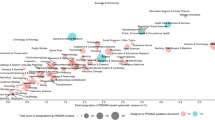Abstract
In all fields of human sciences there has long been a debate whether research of these fields should closely follow the traditional method with accurate measurements and statistical inference. More qualitative approaches have been proposed, by which is ment that the research aim is to use the data in their qualitative form. The purpose of this study was to describe the differences in citations between qualitative and quantitative empirical reports. A total of 262 published reports of research pertaining to the therapeutic community and psychiatric wards in a variety of treatment settings from 1987 to 1992 were analyzed. The main finding of this study was that quantitative reports were more frequently cited than qualitative ones — also when some confounding factors were controlled.
Similar content being viewed by others
References
L. Egghe, R. Rousseau,Introduction to Informetrics. Quantitative Methods in Library, Documentation and Information Science, Elsevier, Amsterdam, 1990 p. 211–227.
A. R. Feinstein,Clinical Epidemiology: The Architecture of Clinical Research, W. B. Saunders Company, Philadelphia, 1985, pp. 392–406.
D. R. Gerstein, L. S. Lewin, Treating drug problems,The New England Journal of Medicine, 323 (1990) 844–848.
B. Godin, R. S. Barker, M. Landry, Besides academic publications: which sectors compete, or are there competitors,Scientometrics, 33 (1995) 3–12.
H. Herbertz, Does it pay to cooperate? A bibliometric case study in molecular biology,Scientometrics, 33 (1995) 117–122.
D. W. Hosmer, S. Lemeshow,Applied Logistic Regression, John Wiley & Sons, 1989.
M. Isohanni, The psychiatric ward as a therapeutic community,Acta Universitatis Ouluensis D 111, University of Oulu, Oulu, 1983, p. 30–31.
D. Kennard,An Introduction to Therapeutic communities, Routledge & Kegan Paul, 1983, p. 50–63.
R. P. Liberman, Research on the psychiatric milieu, In:J. G. Gunderson, O. A. Will, L. R. Mosher (Eds),Principles and Practice of Milieu Therapy, Jason Aronson, New York, 1983, p. 67–85.
T. Luukkonen, O. Persson, G. Sivertsen, Understanding patterns of international scientific collaboration,Science, Technology & Human Values, 17 (1992) 101–126.
M. B. Miles, A. M. Huberman,Qualitative Data Analysis. An Expanded Sourcebook, Sage, Thousand Oaks, 1994, p. 1–14.
H. F. Moed, W. J. M. Burger, J. G. Frankfort, A. F. J. Van Raan, The application of bibliometric indicators: important field- and time-dependent factors to be considered,Scientometrics, 8 (1985) p. 177–203.
B. C. Peritz, Are methodological papers more cited than theoretical or empirical ones? The case of sociology,Scientometrics, 5 (1983) 211–218.
B. C. Peritz, On the heuristic value of scientific publications and their design; a citation analysis of some clinical trials,Scientometrics, 30 (1994) 175–186.
T. Trauer, The current status of the therapeutic community,British Journal of Medical Psychology, 54 (1984) 71–79.
H. K. Wexler, G. P. Falkin, D. S. Lipton, A. B. Rosenblum, Outcome evaluation of a prison therapeutic community for substance abuse treatment,NIDA Research Monographs, 118 (1992) 156–175.
Author information
Authors and Affiliations
Rights and permissions
About this article
Cite this article
Nieminen, P. Type of empirical research reports as an explanatory factor in citation performance of psychiatric research. Scientometrics 35, 309–320 (1996). https://doi.org/10.1007/BF02016903
Received:
Issue Date:
DOI: https://doi.org/10.1007/BF02016903




